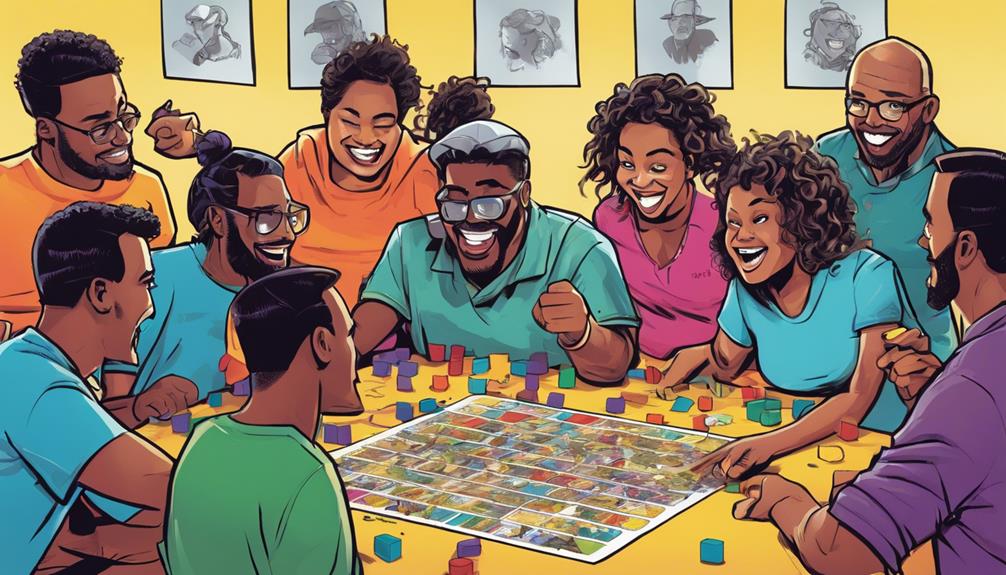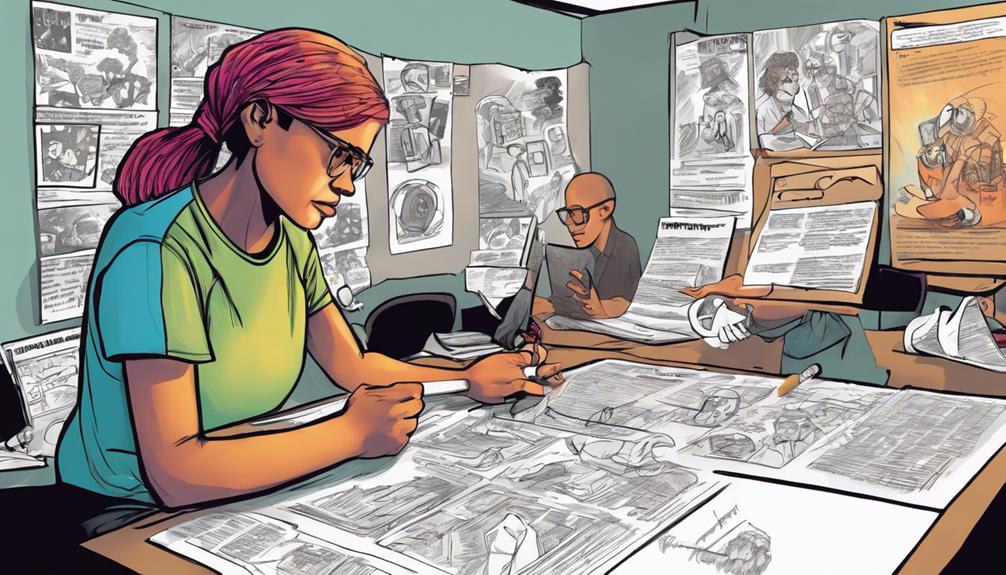Explore how Google utilizes design thinking to innovate by focusing on empathy, ideation, prototyping, testing, and iteration. By immersing in user experiences, generating creative ideas, swiftly prototyping, and continuously refining based on feedback, Google guarantees user-centric solutions. This approach fosters a culture of 10x thinking, leading to revolutionary products. Through a shift towards design-centric values and a commitment to personalized design, Google differentiates itself and exceeds customer expectations. Learn more about Google's innovative design process to understand how they stay ahead in driving innovation and enhancing user satisfaction.
Key Takeaways
- Google empathizes with users to understand needs deeply.
- Ideates collaboratively for revolutionary and creative solutions.
- Rapidly prototypes and tests ideas for user-centric products.
- Iterates based on real user feedback for continuous improvement.
- Evolves design culture towards human-centered and personalized solutions.
Google's Design Thinking Process
Google's Design Thinking process involves five key steps, starting with Empathize and ending with Test.
When it comes to user feedback, Google places significant emphasis on gathering insights to drive product development. At Google, user feedback isn't just a checkpoint but a cornerstone of the design process. It involves actively seeking input from real users, analyzing their responses, and iteratively refining prototypes based on this input.
The iterative nature of Google's Design Thinking process guarantees that user feedback is integrated throughout the development cycle. By incorporating continuous testing and feedback gathering, Google can create products that truly resonate with their users.
This approach allows for quick adjustments based on user preferences and behavior, leading to more user-centric solutions.
Empathy in User-Centric Design

To excel in user-centric design, understanding the user's perspective through empathy is paramount. When it comes to designing products that truly resonate with users, Google places a strong emphasis on empathy as a guiding principle. Here's how Google incorporates empathy into its user-centric design process:
- Immersing in the User's World: Google designers actively immerse themselves in the user's world to gain a deep understanding of their needs, preferences, and pain points.
- Observing and Engaging: By observing and engaging with users directly, designers at Google gather valuable insights that inform the creation of user-friendly solutions.
- Driving the Design Process: Empathy drives every step of Google's design process, ensuring that products aren't only innovative but also genuinely address the diverse and evolving needs of users.
Incorporating empathy into user-centric design enables Google to create products that aren't just functional but deeply resonate with the users they serve.
Crafting Insightful Problem Statements

Crafting informative problem statements involves identifying the user, explaining their need, and providing a key insight to guide the design process effectively.
The problem-solving methodology requires a clear format that includes the user persona, their specific need, and the underlying insight driving the problem.
For instance, a well-crafted problem statement could be: 'Larry is a motorcycle rider who needs to feel secure because he values safety and peace of mind while riding.'
By articulating the user's requirements in this structured manner, teams can better focus on addressing user needs and generating more innovative solutions.
Well-stated problem statements enable teams to understand user pain points deeply, leading to the development of solutions that truly resonate with users.
Essentially, the process of crafting informative problem statements forms a fundamental foundation for successful design thinking and innovation within a team.
Ideation for Creative Solutions

You can expect Google's innovative ideation techniques to spark your creativity and push boundaries.
By engaging in collaborative brainstorming sessions, you'll witness the power of generating a multitude of creative ideas.
Google's approach focuses on fostering a culture of 10x thinking to guarantee solutions aren't just incremental, but truly revolutionary.
Innovative Ideation Techniques
Innovative ideation techniques at Google foster creative solutions through collaborative brainstorming sessions and Blue Sky thinking. When exploring ideation techniques, Google designers utilize specific strategies to drive innovation:
- Blue Sky Thinking: Google encourages thinking without constraints, aiming to push boundaries and generate radical ideas that challenge the status quo.
- 10x Thinking: Designers at Google aim for solutions that are ten times better, rather than incremental improvements, fostering a culture of ambitious innovation.
- Collaborative Brainstorming: Ideation sessions involve diverse teams coming together to share perspectives, spark creativity, and explore out-of-the-box solutions.
Creative Solution Generation
To nurture creative solutions at Google, the ideation process prioritizes generating radical and innovative ideas through collaborative brainstorming techniques. Understanding the true nature of the issue forms the basis for creating impactful solutions. Google promotes Blue Sky thinking, where no idea is too outlandish, to spark breakthrough innovations. The company's promotion of 10x thinking motivates teams to aim for solutions that are ten times better, not just incremental enhancements, fostering a culture of ambitious creativity.
Collaboration plays a pivotal role in Google's ideation process. By involving diverse team members, various perspectives are explored, leading to the generation of genuinely creative ideas. Google understands that improved problem statements lead to better solutions; hence, clear problem definition is crucial for effective ideation.
Furthermore, Google's focus on translating creative ideas into actionable solutions involves creating prototypes and pushing for Minimum Viable Products (MVPs). This approach ensures that innovative concepts aren't just theoretical but practical and achievable solutions in the making.
Design Thinking Applications
During design thinking applications at Google, ideation sessions are structured to encourage Blue Sky thinking for the generation of innovative solutions. Google promotes 10x thinking to push boundaries and generate radical ideas during the ideation process. The design thinking applications focus on brainstorming sessions that foster collaboration and creativity among team members. Ideation for creative solutions involves turning diverse ideas into actionable prototypes for testing and refinement. Google's design thinking approach emphasizes user-centered solutions through iterative ideation and prototyping processes.
By fostering Blue Sky thinking, Google encourages you to think without constraints, enabling the creation of groundbreaking ideas.
Through promoting 10x thinking, Google challenges you to push past incremental improvements and aim for revolutionary solutions.
Action Through Prototyping

You can see how Google benefits from rapid iteration through prototyping to test and refine ideas swiftly.
By gathering user feedback early on, Google guarantees its products are truly user-centric.
Through this approach, Google navigates the design process efficiently, ultimately enhancing the overall user experience.
Rapid Iteration Benefits
Through rapid repetition and prototyping, Google gains valuable insights from real user feedback early in the design process, enhancing the development of user-centered solutions. This approach offers several benefits:
- Quick Identification: Rapid repetition allows Google to quickly identify potential issues or areas for improvement, enabling prompt adjustments to be made.
- Improved User Experience: By actively prototyping and iterating, Google can tailor its products to better meet user needs and preferences, resulting in a more user-centric experience.
- Accelerated Innovation: The emphasis on rapid repetition and prototyping accelerates the innovation process, leading to the creation of innovative solutions that address user requirements effectively.
Google's commitment to rapid repetition not only streamlines the design process but also guarantees that the final products align closely with user expectations.
User-Centric Prototype Testing
Google effectively employs user-centered prototype testing to swiftly gather feedback and refine innovative product ideas. By creating prototypes of various concepts and testing them with real users, Google can validate the effectiveness of new ideas.
Through this user-centered prototype testing, the company can pinpoint user preferences, identify pain points, and uncover usability issues to enhance product designs efficiently. The feedback received from users during prototype testing sessions empowers Google to make well-informed decisions, iterate quickly, and deliver solutions that cater to user needs effectively.
This action through prototyping approach allows Google to align product features with user requirements, fostering innovation and boosting user satisfaction. By prioritizing user feedback and incorporating it into the design process, Google guarantees that its products aren't only innovative but also user-friendly and tailored to meet user expectations.
Testing and Iteration

Testing and iterating through prototyping and user feedback is an essential component of Google's design thinking process. This iterative approach enables Google to refine product concepts based on real user experiences, safeguarding that their solutions are user-centric and effective.
Here's how Google leverages testing and iteration in their design process:
- Rapid Prototyping: Google swiftly creates prototypes to test ideas and gather feedback, allowing them to iterate on designs quickly.
- User Feedback Loops: By incorporating user feedback into their design iterations, Google can validate assumptions, identify flaws, and make informed decisions to enhance their products.
- Continuous Improvement: Through continuous testing and refinement, Google safeguards that their products meet user needs and expectations, driving innovation and growth effectively.
Google's Design Culture Evolution

Embracing a shift towards design-centric values, Google has evolved its design culture over the past decade. Prioritizing user experience, Google now integrates various design disciplines like UX design, illustration, motion design, and typography into its projects. Designers at Google focus on customization, accessibility, and creating lifestyle experiences. They actively engage in events such as Milan Design Week to stay abreast of design trends, reflecting a commitment to evolving their design approach.
This evolution is evident in Google's emphasis on human-centered and personalized design for individual user experiences, making digital interactions softer and more tailored. The company hosts the annual Google Visual Design Summit, where it transforms its spaces into creative studios with maker labs and design libraries to foster a culture that promotes creativity and collaboration.
Google's designers believe in the power of empathetic design to create inclusive products, actively recruiting from diverse communities to build a more inclusive design industry.
Importance of Design Thinking

Understanding user needs and iterating solutions based on feedback are vital aspects of design thinking that drive creativity and collaboration in product development. When it comes to the significance of design thinking, consider the following:
- Improved User Satisfaction:
By focusing on user needs, design thinking ensures that products are tailored to meet user preferences, ultimately leading to higher customer satisfaction levels.
- Brand Differentiation:
Design thinking plays a pivotal role in creating user-friendly products that not only meet but exceed customer expectations. This differentiation helps in building a strong brand identity that resonates with users.
- Competitive Edge:
Tech companies that prioritize design thinking have a competitive advantage in the market. Understanding user needs and delivering well-designed products influence user perception, loyalty, and positive recommendations, giving these companies an edge over their competitors.
Frequently Asked Questions
How Did Google Use Design Thinking?
You ask, "How did Google use design thinking?" They used it to understand user needs, ideate, prototype, test, and iterate. This approach fosters innovation, creativity, and user-centric design, leading to products that satisfy and retain users.
What Is the Design Thinking Process in Google?
So, what is the design thinking process in Google? Well, it starts with empathy, defining, ideating, prototyping, and testing. Designers at Google focus on understanding users, solving problems, brainstorming ideas, making prototypes, and testing solutions.
How Is Design Thinking Used in Innovation?
Design thinking is essential in innovation. By empathizing with users, defining problems, ideating, prototyping, and testing, you can create user-centered solutions. Prioritizing user feedback, iteration, and user-centric design drives impactful and meaningful products.
How Does Google Promote Creativity and Innovation?
To promote creativity and innovation, Google hosts events like the Google Visual Design Summit. You'll find creatives in fields like UX design and motion design. Google's offices are vibrant studios with maker labs and design libraries.
Conclusion
So next time you're stuck on a problem, think like Google and embrace design thinking.
Remember, just like how Google Maps constantly updates its routes based on real-time traffic data, you too can adapt and iterate your solutions to find the best path forward.
Keep empathy, creativity, and prototyping at the forefront of your problem-solving process to truly innovate and make a difference.
Google does it, and so can you!









